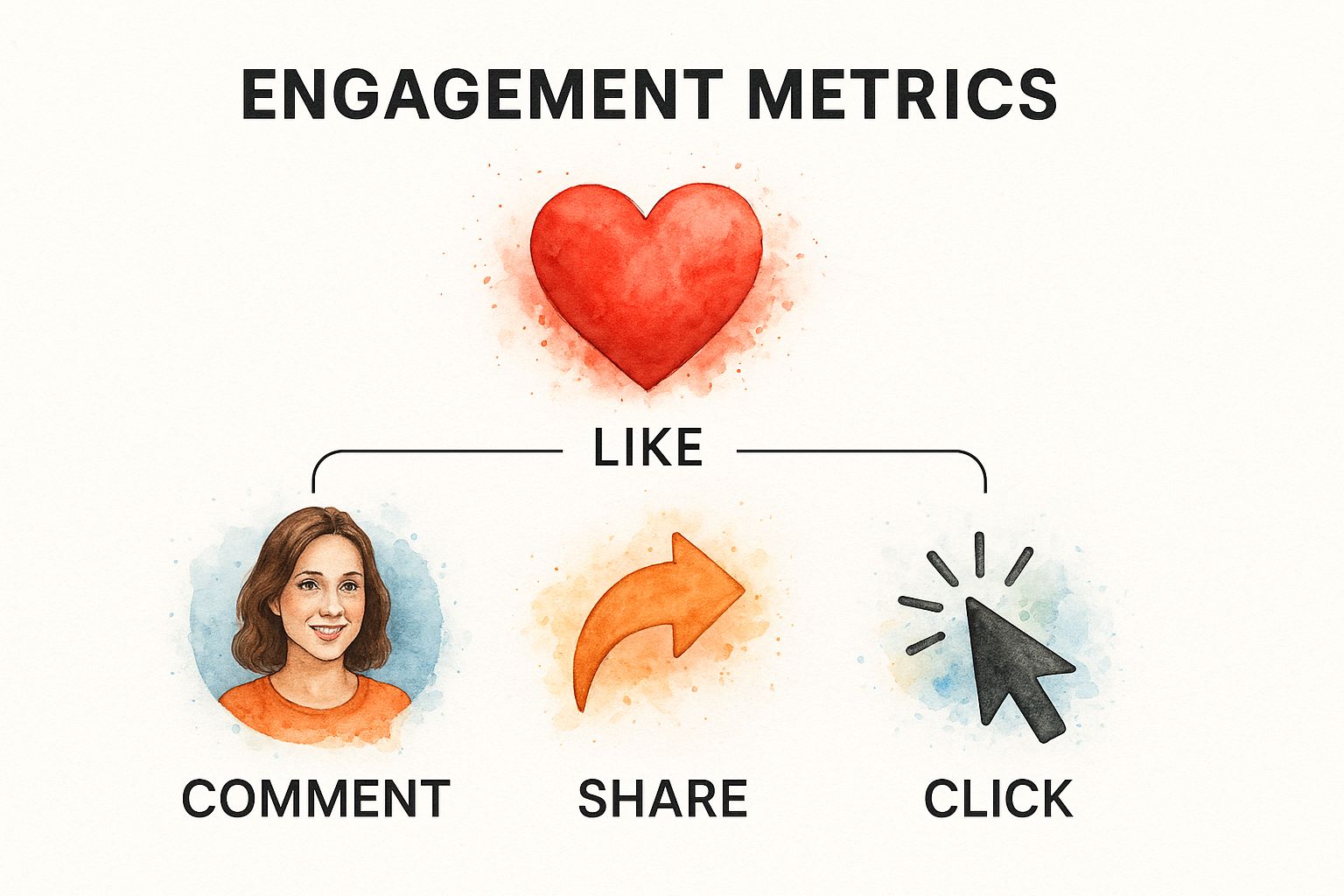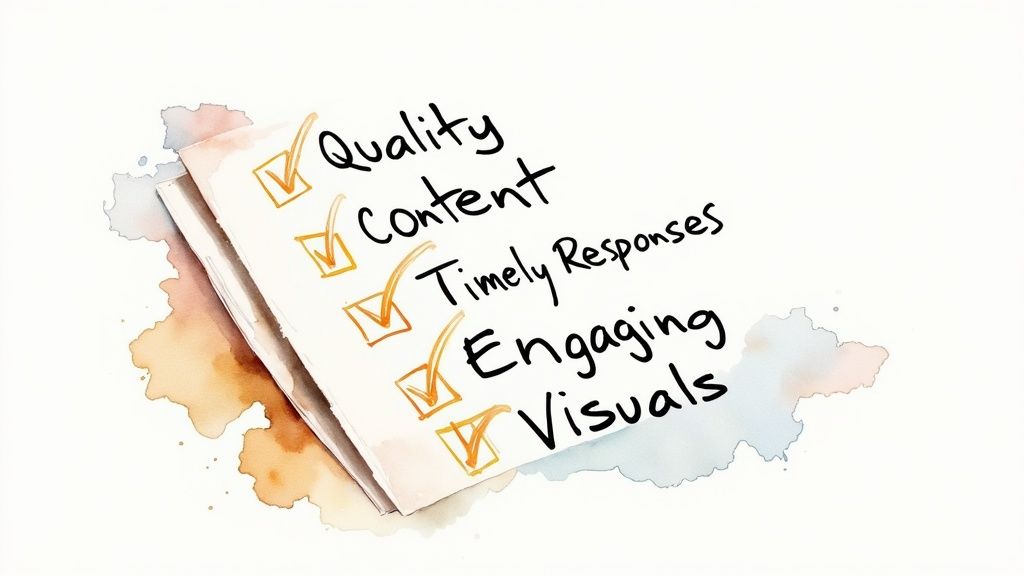Social Media Engagement Metrics Guide: Build Real Results

Why Social Media Engagement Metrics Actually Matter
Trying to grow a brand on social media without tracking social media engagement metrics is like a captain steering a ship without a compass. You might be moving, but you have no idea if you're headed in the right direction. These metrics aren't just abstract numbers; they're direct feedback from your audience, telling you what excites them, what they find useful, and what simply doesn’t land. They are the pulse of your online presence, showing whether you're building real connections or just shouting into a crowded room.
Think of it this way: a thousand likes on a post are like polite nods from a crowd. They're nice, but a single, thoughtful comment is a real conversation starter. It's an open door to building a relationship. Brands that succeed grasp this difference. They don't get caught up in vanity metrics that look good on paper but do little for the business. Instead, they focus on interactions that show genuine interest and build trust, because those are the foundations of customer loyalty.
From Digital Noise to Meaningful Connection
The line between a thriving social media strategy and a stagnant one often comes down to reading these signals correctly. High engagement means more than just popularity; it directly impacts how visible your content is. Social platforms are built to show people more of what they find interesting. When a post gets a flurry of shares, saves, and comments, the platform's algorithm sees it as valuable content and promotes it to a wider audience. This creates a positive cycle: quality engagement leads to more reach, which then generates even more engagement.
This is especially important when you consider the scale of social media today. In 2025, with over 5.31 billion users worldwide—that's almost 65% of the global population—the competition for attention is fierce. People spend an average of 2 hours and 21 minutes on these platforms every day. To stand out, you need to understand what makes your audience stop scrolling and interact.
Predicting Success and Driving Business Results
Beyond just getting more eyes on your content, engagement patterns are powerful clues about future business success. By analyzing what kind of content sparks the most meaningful interactions, you can create a strategy that consistently supports your goals.
The image below shows the incredible growth of social media and the daily time users spend on these platforms, highlighting both the opportunity and the challenge for brands.
This data proves your audience is out there and active. The challenge is giving them content they care about enough to engage with when they have endless other options.
Ultimately, strong engagement metrics are a sign of a healthy community. A brand that encourages conversation and makes its audience feel valued is building something much more significant than a follower count; it's building a tribe. These engaged users are far more likely to:
- Buy from you again and again.
- Recommend your brand to friends and family.
- Offer useful feedback to help you improve your products or services.
- Stand by your brand during difficult times.
In short, tracking the right social media engagement metrics isn’t about boosting your brand's ego. It’s about listening, learning, and adapting to build authentic relationships that directly contribute to your business objectives.
Essential Engagement Metrics That Drive Real Growth
Trying to make sense of social media engagement metrics can feel like learning a new language. Not every signal has the same meaning; some are simple nods of approval, while others show a deep interest that can lead to long-term brand loyalty. To build a winning strategy, you need to understand what these interactions truly represent and focus on the ones that signal a real connection.
The infographic below shows this concept visually, starting from the most basic interaction (a Like) and moving to actions that demand more from your audience, like Comments, Shares, and Clicks.

Each of these metrics tells you something different about how your content is performing. As you move up the hierarchy, each action indicates a stronger level of audience investment and commitment.
The Four Pillars of Audience Interaction
To really understand what your audience is telling you, it’s important to break down the core metrics. Each one offers a unique piece of the puzzle, and knowing their individual importance is the first step toward creating content that truly connects.
-
Likes (or Reactions): This is the most fundamental form of engagement. A "like" is a quick, low-effort nod of approval. It says, "I see this and I acknowledge it." While a lot of likes can help a post get seen, they don't explain why someone liked it. They are a decent surface-level sign of appeal but don't signal a deep connection.
-
Comments: A comment is a big step up from a like. It means a user stopped, thought about your content, and took the time to share their opinion. Comments turn a one-way message into a two-way conversation. Often, the quality of comments is more important than the quantity. A single thoughtful question can be more valuable than a dozen one-word responses.
-
Shares: When someone shares your content, they are personally endorsing it. They’re telling their own network, "This is good, and you should check it out." Shares are a huge driver of organic reach, introducing your brand to new people through a trusted source. This metric shows your content isn't just being seen, but is considered useful or entertaining enough to pass along.
-
Saves: This is one of the most powerful yet often overlooked metrics. A save means a user found your content so useful they want to come back to it later. It’s a strong indicator of high-value, "evergreen" content—like a detailed guide, a recipe, or an inspiring quote. Unlike a share, which can be a fleeting moment, a save signals a user's intent to build a longer-term relationship with your content.
To help you better understand these metrics at a glance, we've put together a table breaking down what each one measures and why it's important for your strategy.
Essential Social Media Engagement Metrics Breakdown
A comprehensive comparison of core engagement metrics, their significance, and what they reveal about audience behavior
| Metric | What It Measures | Why It Matters | Typical Benchmark Range |
|---|---|---|---|
| Likes/Reactions | The immediate appeal and initial visibility of your content. | A basic indicator of content resonance. High numbers can boost a post in the algorithm, increasing its initial reach. | 1-3% of followers per post. Varies widely by platform and industry. |
| Comments | The level of conversation and community your content is generating. | Shows active engagement and builds community. Comments provide direct feedback and open a dialogue with your audience. | 0.1-0.5% of followers. Quality (thoughtful responses) is often more important than quantity. |
| Shares | The perceived value and "shareability" of your content; how much users endorse it to their own networks. | The ultimate word-of-mouth marketing. Shares expand your reach organically to new, relevant audiences. | 0.05-0.2% of followers. A powerful indicator of content that truly resonates. |
| Saves | The utility and long-term value of your content; a user's intent to revisit it later. | A strong signal of "evergreen" or highly practical content. Shows your audience finds your content useful for the future. | 0.5-2% of reach on platforms like Instagram. Often higher for tutorials, tips, and guides. |
This table shows that while likes are a good start, metrics like comments, shares, and especially saves reveal a much deeper connection with your audience.
Looking at these metrics together gives you a much richer understanding of your performance. For example, a post with many saves but few shares might be very useful to your niche audience but not broadly appealing. A post with a lot of comments but few likes could be controversial, sparking discussion without earning widespread approval. If you're looking for more ways to spark these interactions, check out this guide on how to increase social media engagement. By looking beyond the surface numbers, you can adjust your content to meet specific goals, whether that's building a loyal community or driving traffic.
Platform-Specific Strategies That Actually Work
Trying to measure social media engagement metrics with a one-size-fits-all approach is like using a single key for every lock you come across. What works on one platform will likely fall flat on another. Each social network has its own distinct culture, algorithm, and user expectations. The most successful marketers understand this; they don't just syndicate the same content everywhere. Instead, they adapt their approach, speaking the "native language" of each platform to spark genuine interactions.
Think of it as choosing the right tool for the job. You wouldn't use a hammer to turn a screw. In the same way, the energetic, quick-cut videos that go viral on TikTok can feel completely out of place in the polished, professional environment of LinkedIn. True success lies in respecting these platform-specific nuances.
Tailoring Your Content for Maximum Impact
Adapting your strategy doesn't mean you have to change your brand's core identity. It simply means packaging your message in a format and tone that connects with each unique audience. This starts with understanding what each platform's algorithm values and rewards.
-
Instagram: This platform has evolved far beyond simple likes. The algorithm now heavily prioritizes actions that signal deep user interest, like Saves and meaningful Comments. When a user saves your post, it tells Instagram that your content is valuable enough to revisit. Similarly, long, conversational comments are weighted more heavily than single-emoji reactions, indicating a higher quality of engagement.
-
TikTok: The name of the game here is completion rate and immediate engagement. The TikTok algorithm wants to see users watching your videos from start to finish—or even re-watching them. The first few hours after you post are critical. A rapid surge of likes, comments, and shares tells the algorithm your content is a hit and deserves to be shown to a much broader audience.
-
LinkedIn: On this professional network, engagement is all about value. While personal stories can perform well, they must connect back to career development, industry insights, or leadership. Users on LinkedIn are looking for content that teaches them something, sparks thoughtful discussion, or offers a fresh perspective on their field. Generic motivational quotes rarely match the performance of in-depth analysis or well-structured advice.
Understanding these differences is essential, especially when you look at the data. A recent analysis reveals a stark contrast in performance: TikTok boasts an average engagement rate of 2.50%, while Instagram's has dropped to just 0.50%. This 28% year-over-year decline for Instagram highlights the growing challenge of cutting through the noise on mature platforms and reinforces the need for a tailored strategy. You can dive deeper into these performance trends by exploring the full 2025 social media benchmarks study.
To help you align your strategy with what actually works, the table below provides a clear breakdown of the key success factors for today's major platforms.
Platform-Specific Engagement Rate Benchmarks
This table outlines the current engagement rate benchmarks and performance standards across the major social media platforms.
| Platform | Average Engagement Rate | Top Performing Content Types | Key Success Factors |
|---|---|---|---|
| 0.50% | High-quality Reels, Carousels with tips, Authentic Stories | Encouraging Saves, Fostering genuine conversations in comments | |
| TikTok | 2.50% | Short, entertaining videos, Trending audio challenges, Educational clips | High video completion rate, Immediate engagement velocity (likes/shares) |
| 1.25% | Text posts with personal insights, Industry reports, Case studies | Providing professional value, Sparking industry-specific discussions |
As the data shows, each platform not only has a different average engagement rate but also rewards different types of content and user behaviors. A successful social media strategy is one that recognizes these differences and adapts to them, ensuring every piece of content is positioned for maximum impact.
Making Sense of Your Numbers: Analysis That Matters
Looking at your raw social media engagement metrics by themselves is like having a box of puzzle pieces without the picture on the lid. You can see all the individual likes, shares, and comments, but the larger story they tell is completely lost. The real value comes from turning this raw data into clear insights that can actually guide your strategy and lead to better results. This isn't about complex data science; it's about being a detective and asking the right questions.
Think of each metric as a clue. A high number of saves on a post suggests your audience finds the content practical and wants to return to it. A sudden burst of shares might mean you've hit on a hot topic or created something that truly resonates. By searching for these patterns, you can shift from simply reacting to past performance to proactively creating content you know will connect with your audience.
Calculating Your True Engagement Rate
A fundamental first step in your analysis is to calculate your engagement rate. While social platforms often provide their own version of this metric, calculating it yourself creates a consistent benchmark you can use across all your posts and over time. The most common formula is quite simple:
Engagement Rate = (Total Engagements / Total Followers) x 100
However, this formula can sometimes be misleading. A more precise picture often comes from calculating the engagement rate by reach. This measures engagement against the number of people who actually saw your post, not just your total follower count.
Engagement Rate by Reach = (Total Engagements / Total Reach) x 100
This second formula is particularly useful. It tells you how compelling your content was to the audience it reached, stripping away the effects of platform algorithms that might limit who sees your post on a given day. A high rate here is a strong signal that your content is genuinely captivating.
From Data Points to Actionable Patterns
Once you have your engagement rates, the next step is to hunt for trends. This is where you link your metrics back to your actual business goals. You can frame your analysis around a few key questions:
- Which content pillars spark the most conversation? Compare the engagement rates on your educational posts against your behind-the-scenes content or user-generated features. This reveals what your audience truly wants to see from you.
- What time of day is your audience most active? Most social media analytics tools show when your followers are online. Posting during these peak windows can give your content an important initial boost.
- Which formats are performing best? Are your short-form videos getting more interaction than static images? Do carousels with multiple slides earn more saves than single-image posts? Answering this helps you decide where to put your creative energy and budget.
For example, using analytics tools to visualize website traffic from your social channels can show you which platforms are not only driving engagement but also bringing people to your website.

A visual like this makes it easy to see which channels are delivering valuable users to your site, helping you focus your efforts where they matter most. By consistently tracking these patterns, you’ll learn to spot trends early, anticipate what will resonate, and build a content strategy based on solid data, not just guesswork.
Connecting Engagement to Business Results
High engagement numbers look impressive, but if they don't support your business goals, they're just a form of expensive entertainment. The real challenge is to draw a clear line from likes and shares to actual revenue. This means learning to separate the interactions that signal buying intent from those that are merely passing interest. The most successful brands see social media engagement metrics not as the finish line, but as the very start of the customer journey.

This isn't about slapping a dollar sign on every like. It's about recognizing the combined power of engagement. Think of each interaction—a comment, a share, an answer to a poll—as a small deposit into your brand's equity, gently guiding a potential customer forward.
Assigning Value to Different Interactions
Not all engagement carries the same weight for your bottom line. A "save" on a product tutorial often points to a stronger intent to buy than a "like" on a funny meme. To link these actions to real results, brands create simple attribution models. This involves tracking which types of content and engagement most frequently lead to valuable outcomes, like a click to your website, a newsletter subscription, or adding an item to a shopping cart.
For example, you might discover that users who comment on your product demo videos are twice as likely to buy something within 30 days compared to those who only like the post. This insight is incredibly valuable. It tells you to produce more demo videos and encourage conversations in the comments. It also helps justify your spending on social media ads, a market expected to reach $276.7 billion by 2025. You can dig deeper into this trend with a detailed social media statistics report. Knowing which interactions convert is key to spending your ad budget effectively.
Looking Beyond Direct Conversions
While linking engagement directly to sales is a major objective, it’s not the complete picture. Engagement has a powerful, long-term effect on business health that standard sales metrics don't always capture. Building a vibrant online community creates a protective buffer around your brand.
Here’s how quality engagement builds lasting value:
- Boosts Brand Awareness: When people share your content, they become brand advocates. They introduce you to their networks with a built-in recommendation.
- Fosters Customer Loyalty: Replying to comments and messages shows customers they are heard and appreciated, strengthening their bond with your brand.
- Drives Word-of-Mouth Marketing: An active community can become a marketing force of its own. Loyal followers will often defend your brand, suggest your products, and provide priceless user-generated content.
Connecting engagement to results requires a change in thinking. You can explore more ideas by looking into effective social media growth strategies that embrace this approach. By seeing every interaction as a touchpoint that builds momentum, you can finally demonstrate the real business impact of a lively social media presence.
Proven Tactics for Higher Quality Engagement
Understanding your social media engagement metrics is the first step, but actively improving them is a different game entirely. To drive real interactions, you need a strategy that goes beyond just posting content and hoping for the best. It requires a thoughtful approach built on understanding your audience and the art of storytelling. The objective isn't just to get attention, but to earn it by creating content that truly connects and starts a real conversation.
Think of yourself as the host of a great party. A good host doesn't just put out snacks and drinks; they introduce people, ask interesting questions, and create an atmosphere where everyone feels comfortable sharing. Your social media presence should function the same way. This means building a content strategy around principles that naturally invite interaction, rather than desperately asking for it. When you focus on creating value and telling great stories, engagement becomes a natural result of your efforts.
Go Beyond Basic Scheduling
One of the most effective ways to increase interaction is to understand not just when your audience is online, but when they are most ready to engage with your message. Standard analytics can show you peak online hours, but more advanced tools can provide deeper insights.
For instance, Meta's Creator Studio helps you pinpoint optimal posting times based on your past performance data, as shown in the example below.
This kind of data allows you to move from generic "best times to post" advice to a personalized schedule that fits your specific audience's behavior. The key is to test different posting times based on these insights and measure how timing affects engagement for different types of content.
Create Content That Sparks Conversation
The most shareable content often triggers an emotional response or provides such clear value that people feel an impulse to pass it on. Instead of simply stating facts, frame your content around questions, challenges, or surprising statistics that make people pause and think.
Here are a few proven methods to get the conversation started:
- Ask Open-Ended Questions: Instead of a simple yes/no question, ask something that requires a real answer. For example, rather than "Do you like our new feature?" try asking, "What's the first thing you would do with our new feature?"
- Share Actionable Tips: Create content that people will want to save and come back to later. A carousel post detailing "5 Ways to Improve Your Morning Routine" is much more likely to be saved and shared than a straightforward promotional post.
- Embrace Storytelling: People connect with stories, not just products. Share behind-the-scenes moments, customer success stories, or even the hurdles your brand has overcome. Authentic stories build trust and make your brand more relatable.
Turn Followers into a Community
Ultimately, the highest level of engagement comes from a strong community. This is the point where your followers stop being a passive audience and start interacting with each other. Building this kind of environment takes consistent effort but delivers huge returns in loyalty and brand advocacy. It involves actively participating in conversations, recognizing your most active followers, and making your social channels a valuable place to be.
By focusing on these tactics, you can transform your social media presence from a simple broadcast channel into a thriving hub of interaction that supports real business growth. For a more detailed look at this topic, our guide on social media community management offers a complete roadmap.
Your Roadmap to Sustainable Engagement Success
Turning your knowledge of social media engagement metrics into a working system requires a clear plan. After all, understanding these concepts is one thing, but applying them is what drives results. This guide will help you build a strategy focused on engagement that can scale with your brand. The aim isn't to chase fleeting viral moments, but to create a lasting cycle of interaction that builds a genuine community and helps you reach your business goals.
Think of it like building a house. You wouldn't pour the foundation without a blueprint; this roadmap is your blueprint for engagement. It provides the structure for setting practical goals, running tests to see what your audience loves, and creating reports that offer real insights, not just a pile of numbers. This approach is effective whether you're a one-person shop or an agency managing several clients.
Setting Realistic Benchmarks and Goals
Before you can measure improvement, you need to know where you stand. The first step is to establish a baseline using your current performance and relevant industry standards. It's counterproductive to compare your small business's engagement to that of a massive global brand. Instead, focus on your own journey and progress.
- Calculate Your Starting Point: For the next 30 days, track your average engagement rate per post. Using the engagement rate by reach formula gives you a more accurate picture. This number is your initial benchmark.
- Set an Achievable Goal: Aim for a small but steady improvement. A target of increasing your engagement rate by 10-15% over the next quarter is much more manageable and motivating than trying to double it overnight.
- Define Success Indicators: What does success look like beyond the metrics? It could be getting five high-quality comments each week or seeing a 20% bump in shares on your educational posts.
Creating a Testing Protocol That Works
The only way to truly understand what your audience wants is to test different approaches. By creating a simple testing schedule, you can experiment with various content elements. This process takes the guesswork out of your strategy and replaces it with decisions backed by data. For the clearest results, make sure your tests isolate one variable at a time.
| Test Variable | Example A | Example B | What to Measure |
|---|---|---|---|
| Content Format | A single high-quality image post. | A carousel post with five slides. | Compare saves and comments. |
| Call to Action | "Learn more at the link in bio." | "What's your biggest challenge with X? Tell us below!" | Compare comment volume and quality. |
| Posting Time | Post at 9 AM on Tuesday. | Post at 7 PM on Tuesday. | Compare initial engagement velocity (first 3 hours). |
| Visual Style | A professional, polished graphic. | A candid, behind-the-scenes photo. | Compare likes and shares. |
This structured method for analyzing social media engagement metrics transforms your content creation into a series of small, manageable experiments. Each test provides useful feedback, guiding you to do more of what works and less of what doesn't.
Feeling stretched thin by the need to constantly interact and post? Imagine an AI-powered tool that manages engagement for you, keeping your profile active 24/7. GrowChief automatically interacts with relevant accounts and content, starting conversations and increasing your visibility while you focus on other parts of your business. See how automated engagement can help by starting your free seven-day trial at GrowChief.com.






